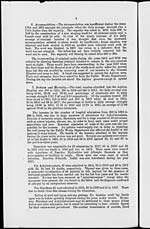Medicine - Mental health > 1912-1924 - Annual returns of the Patna Lunatic Asylum at Bankipore in Bihar and Orissa > 1915-1917 - Triennial report on the working of the Patna Lunatic Asylum in Bihar and Orissa for the years 1915, 1916 and 1917
(175) [Page 1]
Download files
Individual page:
Thumbnail gallery: Grid view | List view
![(9) [Page 1] -](https://deriv.nls.uk/dcn17/8389/83895520.17.jpg)
TRIENNIAL REPORT ON THE WORKING OF THE PATNA LUNATIC
ASYLUM FOR THE YEARS 1915, 1916 AND 1917.
1. THIS is the Second Triennial Report on the working of the Patna
Lunatic Asylum, embracing the years 1915, 1916 and 1917.
2. Statement I.—Deals with admissions and discharges. The total number
of lunatics under confinement was 309 in 1915, 302 in 1916 and 295 in 1917
or an average of 302 against 279 in the previous triennium. The daily average
was 315.18 in 1915, 310.03 in 1916 and 299.74 in 1917. Of the total
number resident on the 31st December of each year under report, criminal
lunatics constituted 47.57, 48.01 and 48.47 per cent, respectively, the average
being 48.01 against 41.04 in the preceding three years.
3. Admissions.—The total number of receptions (excluding those re-admit-
ted) was 94 in 1915, 72 in 1916 and 76 in 1917, the average being 81 against
82 in the previous triennium. The variations are generally difficult to
explain.
4. Re-admissions.—The total number re-admitted was 5 in 1915,16 in 1916
and 13 in 1917. Of the re-admissions 15 were criminals and 19 non-crimi-
nals. Out of 5 re-admissions in 1915, 4 were criminals, 3 of whom returned
to the Asylum after trial and 1 was admitted after an absence of 6 years
5 months and 12 days. The large increase under head re-admissions during
the years 1916 and 1917, was due to observation cases now being shown as
discharged otherwise and re-admitted. [Vide Government of India letter
No. 328 of 24th April 1915, to the Secretary to the Government of Bihar and
Orissa, Municipal (Medical) Department.]
Out of 16 re-admissions in the year 1916, 6 were criminals, 3 of whom
were re-admitted after trial. One criminal female lunatic, who was received
from Bhagalpur Central Jail and was sane on admission, was transferred
again to Bhagalpur Central Jail under Government orders but returned to this
Asylum after two months and eight days. She is certainly not insane but
makes herself obnoxious in jail as she seems to prefer the Asylum in which she
is exceedingly useful. Two criminal lunatics were received after long intervals.
One non-criminal lunatic who was discharged cured had a relapse after four
months and was re-admitted. The rest 9 cases were re-admissions from
observation cases.
There were 13 re-admissions in the year 1917, 5 of whom were criminals,
3 being re-admitted after trial. Two criminal and 1 non-criminal lunatics
who escaped from this Asylum were recaptured and re-admitted into the
Asylum. The rest, 8 cases, were re-admissions from observation cases.
Considering that the re-admissions formed such a small proportion of cases
it may safely be stated that most of the lunatics who were discharged cured
returned to the world as useful members of society.
5. Discharges.—The total number discharged during the years 1915,
1916 and 1917 was 48, 58 and 57, respectively. Of these, 37, 28 and 38 recovered
and 7, 10 and 7, were made over to the care of the friends of the lunatics in
improved condition. In 1916, 4 lunatics were taken charge of by their friends.
The percentage of recoveries calculated on daily average strength was 11.73 in
1915, 9.03 in 1916 and 12.68 in 1917, giving an average of 11.15 against
8.03 in the previous triennium. The percentage of recoveries among females
was 9.28 in 1915, 6.75 in 1916 and 6.76 in 1917 and that among males 12.12,
9.41 and 13.71, respectively. There was an increase of recoveries amongst the
inmates, the cause of this being the milder nature of the cases treated. One
lunatic found to be a leper in 1917 was transferred to the Albert Victor Asylum
for Lepers at Gobra where there is a ward for the reception of such cases.
Set display mode to: Large image | Zoom image | Transcription
Images and transcriptions on this page, including medium image downloads, may be used under the Creative Commons Attribution 4.0 International Licence unless otherwise stated. ![]()
| Permanent URL | https://digital.nls.uk/83895518 |
|---|




